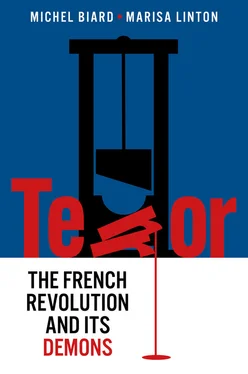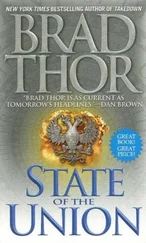Terror and flight were the order of the day for the odious hordes. The French troops cannot follow the flight of the imperial eagle, and the lands of Belgium are not so wide, and lack enough strongholds, to protect or hide the flight of the confederates … Ostend was the barbarous warehouse of the royal coalition, the overflowing granary of the armies, the most complete arsenal of tyrants, and the infernal support of the London court, which will also be taught to know terror, just like its satellites make its deadly experience … Terror and discouragement reign today among the slaves. 30
The expression ‘panic terror’ ( terreur panique ) can be found in a considerable number of letters, speeches and other texts, either to describe the disarray of withdrawing troops or to evoke the fears raised by rumours (founded or not) that circulated throughout the countryside as in the time of the Great Fear in July–August 1789 or at the time of the aborted flight of the king to Varennes in June 1791. 31Similar ‘panic terrors’ were assimilated to the effects of counter-revolutionary manoeuvres to sow panic and unleash unrest. The fear of running out of bread in Rouen soon appeared to be the result of these conspiracies, an echo of the old belief in the famine conspiracy which made it possible to present a simple, popular explanation rather than a detailed economic analysis of circuits of product and commercialization: ‘A terreur panique or the manoeuvres of a few malicious people led Rouen into experiencing a fake shortage as in Paris. The doors of bakeries were assaulted for very little reason.’ 32Rumours of troubles near Meaux were similarly explained in a speech by Barère where the word ‘terror’ is repeated to the point of saturation: he mentions the ‘sounds of terror sown in the countryside to frighten the imagination of citizens, causing commotion or trouble’; he urges his audience to ‘publish by what exaggerated sounds, by which means of terreur panique they infect the countryside, distracting inhabitants from agricultural work, propagating disorder and fear in the cities’; he describes how enemies ‘throw fake terrors into our countryside’. 33
‘Terror’ can also have a political meaning, though without necessarily relating to a concerted policy of terror. Such use of the word was first linked to the idea of justice and the fact that opponents of the Revolution should fear punishment. Following the September prison massacres of 1792 (for more on the September Massacres, see chapter 7), the minister of the Interior, the Girondin Roland, linked the birth of the Republic with ‘the terror of all the traitors’ and an alliance of all ‘friends of the country’. 34One heavy symbol of this was the silence of the members of the Commune of Paris, at a time when they were to be targeted by the Girondins, once they had condemned the massacres of September. 35
Feeling ‘terror’ while facing justice and the exemplarity of punishment constitute a theme that appeared on a number of occasions, especially during the trial of the ousted king. The trial was conducted by the National Convention itself, with the deputies in their function as ‘representatives of the people’ to pass judgement on the erstwhile king on behalf of the people. In early December 1792, Robespierre channelled this idea by calling for the creation of a monument to the martyrs of liberty, killed in the assault on the Tuileries palace that resulted in the overthrow of the monarchy on 10 August 1792. This monument was intended to convey a double political meaning: ‘nourish in the heart of people the sentiment of their rights and the horror of tyrants, and in the heart of tyrants the salutary terror at the thought of the people’s justice.’ 36Other members of the Convention approved of this meaning, as on 16 and 17 January 1793 when every member was given the floor to justify his vote on Louis XVI’s fate. The Montagnard Sergent expressed his support for capital punishment in dramatic terms: ‘A king’s head only falls with a crash, and his torment inspires a healthy terror [ terreur salutaire ].’ 37Does this mean that the origins of the Terror lay in the fall of the monarchy and the execution of the king? This was undoubtedly true for the link between ‘terror’ and ‘justice’, but it was not the case for ‘terror’ as a ‘system’.
In the early days of the Convention, enmity between the two factions of the Convention, Girondins and Montagnards, went deep, their previous conflicts deepened to a chasm by the trauma of the September Massacres. Each side accused the other of employing ‘terror’ against them, though they took conflicting views of its meaning. In October 1792, Marat, the last person one would expect in this context, denounced the Girondin Rouyer for having made threats destined to ‘keep him away through terror.’ 38Louvet, another Girondin, replied two weeks later in a violent speech against Robespierre, whom he accused of being accompanied everywhere with armed guards and of being, like Marat, the ringleader of a ‘dissenting faction, escorted by terror and preceded by the placards of the blood-thirsty man’ – the ‘faction’ being responsible for the September Massacres. 39Two weeks after this speech, Barère, who sat at the head of the Plain (unaligned deputies in the Convention) before later joining the ranks of the Montagnards, spoke for the first time of a ‘system of terror’ put in place by those who had ordered the massacres of prisoners and favoured what he called ‘anarchy’. 40Was the case settled when several Girondins denounced the ‘terror’ fuelled by the Montagnards and the Parisian sans-culotte movement? The Girondin Vergniaud used a moving phrase on 10 April 1793, when he stated: ‘People have sought to bring about the revolution through terror, I would have liked to bring it about through love’, only to return, moments later, to denouncing his political enemies, the Montagnards, once more. 41It would be a mistake to form any easy conclusions, especially since a number of Montagnards continued to use the word ‘terror’ against their opponents, like Marat or even Saint-Just. 42Saint-Just, in his report against the Girondin leaders, attributed policies of terror to them:
In the provinces it is said that there are slaughters in Paris; in Paris it is said that there are slaughters in the provinces … This was true in Bordeaux, Marseille, Lyon, the North, and in Corsica, where Paoli spoke out against anarchy. In the midst of these upheavals, the Commission of Twelve was formed to seek out the conspirators, but its members were their supporters. It stripped Hébert of his functions, as the despot had done; it wished to impose terror on the citizens. 43
The word ‘terror’ also took pride of place in speeches given upon the assassinations of two representatives of the people: firstly, when Le Peletier de Saint-Fargeau was stabbed by a royalist, enraged by the execution of the king on 21 January 1793, 44and secondly, that of Marat. 45It was the assassination of Marat that triggered what historian Jacques Guilhaumou has called a ‘return to the terror of the other’. 46One might say that the situation changed from a ‘terror’ one suffered under to an active ‘terror’.
3. ‘Terror as the order of the day’: an unsaid, unofficial yet widespread order from the Convention
On 13 July 1793, a young woman from Normandy, Charlotte Corday, bluffed her way into the apartment of the Montagnard and incendiary journalist, Jean-Paul Marat, and stabbed him in his bath with a kitchen knife that she had earlier bought for that purpose. His assassination, along with that of Le Peletier, heightened the sense of fear amongst the deputies, by making evident their own susceptibility to physical attack, a vulnerability made more intense by the ideological conviction that a virtuous politician should be accessible to the public, and not hide away behind guards and palace walls. 47The assassination of Marat and his very public funeral heightened desire amongst Paris radicals to repress the adversaries of the Revolution. Numerous speeches to that effect were given in the clubs, especially the Cordeliers, and also in the Convention, reinforced by envoys from primary assemblies. 48Hailing from all over France, these envoys gathered in the capital to lend their massive support to the vote for the new constitution. Some Girondins in hiding in the provinces spread the vision of an Assembly reduced to a sort of ‘rump parliament’, not unlike the British parliament after the first British civil war. 49Yet the Montagnards intended to use the presence of these thousands of envoys to project another image of Paris. On 9 August 1793, on the eve of celebrations for the first anniversary of the attack on the Tuileries and the proclamation of a new constitution, Gossuin presented a report on behalf of the commission in charge of gathering the minutes of the validation process for the new constitution. The report showcases the two conflicting representations of the capital by using the word ‘terror’:
Читать дальше












